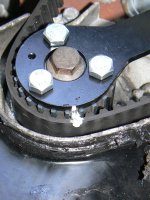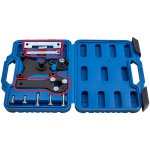Hi. Just picked up on this due to Jack mentioning me.
When doing this job "freehand" (i.e. without using a locking tool kit) If you mark the old belt and crank and cam pulleys (I usually mark the head and block too just for extra security) before you slacken the old tensioner. Then transfer the markings from the old belt to the new one (counting teeth to be quite sure) and fit the new belt so the marks line up with the pulleys, then all will be well when you tighten the tensioner. Of course doing it this way finishes up with the timing being the same as it was when you started. On the later engines (not just those with the VVT cam sprocket) the cam sprocket is unkeyed. You won't be slackening the cam sprocket retaining bolts so, as doing it this way, will result in the engine being timed exactly as it was before you started there is always the slight risk that someone else before you may previously have slackened the cam sprocket bolt and then tightened it without meticulously lining it up correctly. This will result in the timing being "out" and you won't know about it unless you have the timing tools. However, if it's been running well and, especially if this is it's first belt change, the likelyhood is that it's all going to be absolutely fine.
When I did Becky's belt (she's a 2010 1.2 with the solid but unkeyed cam sprocket) I was very keen to try doing it without slackening the cam sprocket bolt - I'm a firm believer in letting sleeping dogs lie if at all possible. Although I'd done belts on the older engines with the keyed cam sprocket - for which you don't need timing tools as the sprockets are marked and you just line up the marks - I hadn't done one of the unkeyed type (done my own and my boy's Punto with VVT now) so I bought a "cheepie" set (Nielsen) off ebay and fitted the timing tools "just in case" - the black thing bolted with it's 3 bolts to the crank sprocket is part of the kit. I then marked up the crank and cam sprockets and ignored the timing tools. Took the old belt off, transferred the marks to the new belt and fitted the new belt with the marks aligned. I took the CAM locking tool out to do this so I could "juggle" the cam sprocket to gain a wee bit of slack so I could get the marks lined up. After tightening the tensioner I rechecked that the cam locking tool slid back into it's slot which confirmed to me that the timing was indeed correct. The crank having remained locked with the tool you can see in the pics - which is irrelevant except that I wanted to check it on completion. I did the Punto by tippexing alone but then, after everything was fitted and the tensioner tensioned I locked up the crankshaft with the black tool and tried the cam locking tool in it's slot - it dropped right in confirming that the timing on it too was spot on. Both cars are running well and neither have illuminated their check engine light - which might indicate a "Phonic Wheel relearn" is required.
Phonic wheel relearn? I hear you saying. These newer engines have position sensors on their camshaft and crankshaft. Some people report problems with the check engine light illuminating after a belt change whilst others seem to get away with it and I'm very interested in this so I've been looking into this "phenomenon" The crankshaft sensors are all in the same place (as far as I know) but there are two cam sensor positions. On earlier engines like my 2010 Panda (60hp) the sensor is on the front end and triggers off the cam sprocket. The later engines - like my boy's Punto with it's VVT pulley - has the sensor on the back end of the head and reads off the slots in the cam itself. I've spoken to a number of the wee garages around here, being ex-trade I'm quite a "weel kent face" and they mostly do belts on these engines, whether it's in a Fiat/Ford etc, by the tippex method and no-one said they experience problems with the CEL coming on. The Fiat main dealer tells me they always slacken the cam sprocket and use the locking tools and recon it's almost guaranteed to light the CEL if a Relearn is not done. So here's my theory as to why some light up and others don't:
Today's cam belts are very very accurately made so, no matter whether you buy a Gates (my prefered brand) a Dayco, Conti, or whatever I very much doubt if there is even a "smidgeon" of difference between them. So I don't believe it's the new belt which in itself is causing the light to illuminate - by the way it illuminates because the ECU is constantly comparing, and learning as it wears very slightly, the angular relationship between the cam position and crank position to achieve best performance. If it sees a big change it flags the light up because it gets "worried" all is not well. Typically, by the way, it flags up a missfire code which can lead you on a very merry and long dance looking for a non existent fault. - However if you slacken the cam sprocket retaining bolt (which people tell me is very tight indeed) then, if you have the later engine - so I think they all have the sensor on the back end of the cam (it will if it's a VVT for sure) - even with the timing tools in place (and you mustn't tighten the cam bolt with the cam locking tool in place for fear of damaging the end of the cam) I'm betting the relationship between the cam sprocket and the cam itself is going to be very slightly different. The crank/cam sensor relationship seems to be quite critical so as soon as the ECU "clocks" that things are not quite as they were last time it ran, it lights up the CEL. It seems to do this often not on first start up and sometimes not even just when pottering around town but the first time (post belt change) you go for a decent run, maybe on the open road or motorway, it lights it up.
I've attached a couple of the pics I took at the time. There's a more in depth account somewhere on here under the "Becky's timing belt" heading if you'd like to look for it. So if you do this and if no-one before you has set the cam sprocket wrongly then it works brilliantly.
By the way, it's Pugglt - with an L not an i, maybe that's why flagging me didn't work? - I've noticed a few people get it wrong. Means "old, worn out and a wee bit daft" I got it from an elderly Geordie gardener who worked for my Dad back in the '60s!
Strewth, that was a bit long winded, sorry. Hope it was of some help?







